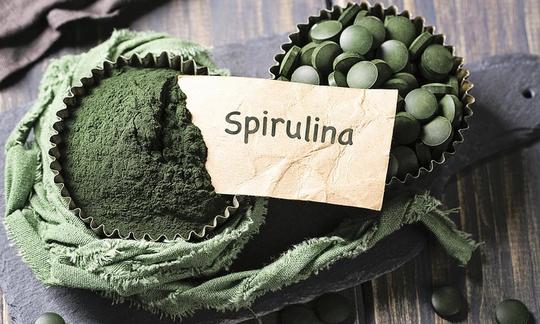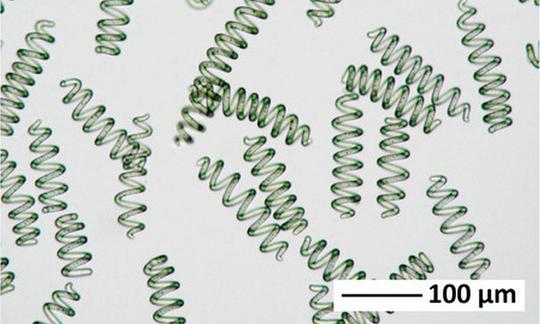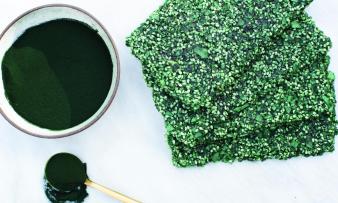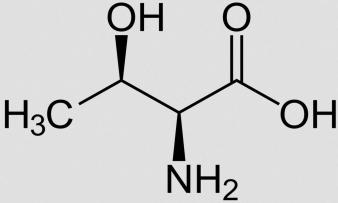Table of contents
In contrast to the microalgae Chlorella, Spirulina ( Arthrospira) is not a true algae (see "General Information"). Spirulina is available from conventional and organic aquaculture and is heated, so it is practically never available raw.
Using spirulina in the kitchen:
In small quantities, spirulina powder, sticks or flakes are suitable for many recipes. Although spirulina is rich in nutrients and proteins, the highly processed food supplement used in small doses plays a minor role in covering the daily requirement. If you are still concerned about preserving the ingredients, you should not heat spirulina to high temperatures.
Spirulina powder, with its striking, intense green color, works very well as a natural colorant in preparations. Ingredients such as spirulina or chlorella can be used interchangeably in recipes.
Spirulina powder has a relatively neutral to slightly fishy taste. Recipes with spirulina (spirulina recipes or spirulina powder recipes) can include drinks such as smoothies, shakes or tea as well as overnight oats, muesli, crackers, chia pudding, soups, guacamole, desserts, creams or sauces. The powder is also suitable for coloring doughs and mixtures for bread, cakes, muffins, gnocchi, pancakes or spaetzle. Spirulina granules, sticks or spirulina flakes (alternatively: crushed tablets) can be eaten as a topping on salads, sandwiches, cakes, raw vegetables and the like.
Vegan recipe for cucumber spaghetti with spirulina:
Ingredients (for two people): 1 cucumber, raw; 1 heaped teaspoon spirulina powder; 3 tablespoons freshly ground linseed (e.g. in an electric coffee grinder); 1 teaspoon rapeseed oil, cold-pressed; 4 g dulse flakes, dried.
Preparation: Use a spiral cutter to cut the cucumber into spaghetti-like, raw noodles and mix them with the spirulina powder, the crushed linseed and the rapeseed oil. Finally, sprinkle the naturally slightly salty dulse flakes over the raw and vegan vegetable spaghetti.
Note: Since spirulina is heated during production, the cucumber dish is strictly speaking no longer raw food.
Vegan spirulina recipes can be found under the note: " Recipes that have the most of this ingredient ".
| Not only vegans or vegetarians should read this: Vegans often eat unhealthily. Avoidable nutritional errors. |
Shopping - where
to buy spirulina? Where can you buy spirulina? Spirulina can be bought as tablets, pellets, powder, sticks (sequins) or flakes. Spirulina is available in conventional and organic quality as a food supplement from supermarket chains such as Coop, Migros, Rewe, Aldi, Lidl or Hofer as well as in organic shops, health food stores and online. We have not yet found any spirulina in supermarkets such as Edeka, Volg or Spar or in organic supermarkets such as Alnatura or Denn's. Manufacturers use spirulina as an ingredient in foods such as pasta, fruit bars, drink powder, etc. Season: Dried spirulina or products containing spirulina can be bought all year round.
Spirulina has not previously been available in raw quality or raw food quality. Due to the manufacturing process, spirulina often undergoes heat processes of more than 42 °C and is therefore heated. Recently, sales websites have been advertising alleged raw food quality and gentle drying at less than 42 °C, but we have not yet found any concrete evidence of this.
Spirulina products may be contaminated with heavy metals, PAHs (polycyclic aromatic hydrocarbons) and toxins. Therefore, you should prefer residue-controlled and organically certified products from closed systems (aquaculture). Organic products with the Naturland label, e.g. spirulina powder, are characterized by high and controlled organic quality. 1
Manufacturers confusingly advertise spirulina products as an "unparalleled source of energy" (protein content) with "considerable vitamin and mineral content", "lots of vitamin B12 - important for vegetarians" or "three times more chlorophyll than wheatgrass, passes stored solar energy on to humans" as well as "the most valuable food on the planet". 1
However, with the highest recommended daily dose, the amount of nutrients consumed is so small that the additional intake, e.g. of amino acids/protein, is barely noticeable. Chlorophyll can be obtained from any food containing green plant parts, e.g. nettles, parsley, spinach, broccoli, green beans. According to the Health Claims Regulation, Spirulina capsules may no longer be advertised as a way to lower blood sugar levels. The advertising of the predominantly analogue vitamin B12 (pseudo-vitamin B12) is also considered misleading if it promises disease-relieving effects. 2,3,4 The advertising of "Spirulina - rich in vitamin B12 " has now been prohibited in Germany by the Berlin Higher Regional Court in a ruling dated January 28, 2011 (5 U 133/09). 9
Storing Spirulina:
Spirulina should be stored protected from atmospheric oxygen, moisture and light. Sealable containers such as cans or jars are suitable.
Spirulina ingredients - nutritional values - calories:
Spirulina powder and spirulina preparations have nutritional values of 290 kcal/100g. The main nutrients per 100g are 7.7g fats, 24g carbohydrates and 57g proteins. When spirulina is heated, the heat-sensitive spirulina ingredients suffer.
100 g of spirulina per day would theoretically cover more than the daily requirement of protein, as well as the daily nutrient requirement of copper, iodine (iodine), riboflavin (vitamin B2), iron, thiamine (vitamin B1) and sodium. 5,6 How much spirulina per day? Manufacturers recommend an intake of four grams or six to ten tablets or two teaspoons of powder per day. This means that the actual nutrient coverage is low.
You don't have to resort to expensive nutritional supplements to cover your daily protein needs. Whole grains such as oatmeal (13 g/100g) and pulses such as cooked lentils (9 g/100g), cooked chickpeas (9 g/100g) or cooked kidney beans (8.7 g) are rich in protein. Especially when combined with grains and pulses, plant-based foods contain protein with a high biological value. 5,6
Since spirulina grows in mineral-rich freshwater and in salt lakes, the iodine content is low compared to seaweed. Four grams of spirulina contain 18.24 µg of iodine. Which algae contain a lot of iodine? The edible algae that are particularly rich in iodine include bladder wrack (300,000 µg/100g), laminaria (kelp, kelp forests) with 300,000 µg/100g, kombu algae (200,000 µg/100g) and arame algae (70,000 µg/100g). Wakame (4,200 µg/100g) and nori (3,215 µg/100g) contain slightly less iodine than the dried red algae species dulse (7,500 µg/100g). 6,7 However, the natural iodine content of algae can vary greatly.
The vitamin B12 contained in spirulina is mainly found in its analogue form, which the human body cannot use. Pseudo-vitamin B12 (analogue/analogues) in food should be avoided, as it blocks the receptors for the usable vitamin B12 form (cobalamin). 29 Most edible blue-green algae (cyanobacteria) are not suitable for use as a source of vitamin B12. 1,8,9,22,23,24 According to current knowledge (2019), a sufficient supply of vitamin B12 in a vegan diet is only possible by taking a supplement. 9
Which is better, chlorella or spirulina? Chlorella is also very rich in nutrients and has a high protein content of 51-58% with a biological value of 53-77%. Due to the small amount of raw materials contained in a tablet, the highly praised levels of vitamins, minerals, proteins and chlorophyll in chlorella are also negligible. 20
The complete ingredients of Spirulina, the coverage of the daily requirement and comparison values with other ingredients can be found in our nutrient tables in CLICK FOR below the ingredients picture.
Health aspects - effects:
Is spirulina really that healthy? Spirulina is said to have positive effects on health. Some researchers give the impression in their studies that spirulina helps with asthma, allergic rhinitis, chronic joint pain or non-alcoholic fatty liver disease. 10 Can you lose weight with spirulina? Other claims include performance-enhancing effects and that spirulina is said to help with weight loss 11,12 and diabetes 13,14,15, improve heart health and reduce the risk of cardiovascular disease. 13
However, the clinical studies on humans (some of them randomized and controlled) on spirulina have been poorly conducted. In some cases, a large amount of data is missing to verify and understand the accuracy of the results. These studies are therefore not sufficiently conclusive to prove or disprove the claims made. 10,11,12,13,14,15
Numerous scientific studies on the possible effects of spirulina were carried out on laboratory animals or in test tubes. Since the active ingredients behave differently in these animals than in the human body, such studies do not allow any conclusions to be drawn about their effects on humans. 10
What are spirulina and chlorella good for? Microalgae (eg chlorella, but NOT spirulina) synthesize active forms of omega-3 fatty acids. These include the two long-chain polyunsaturated fatty acids EPA (eicosapentaenoic acid) and DHA (docosahexaenoic acid), which are essential for the human diet. In order to benefit from these essential fatty acids, e.g. if there is an increased need during pregnancy and breastfeeding or as you get older, you should use carefully produced microalgae oils and not tablets or powders. 20,21 We believe that calling dry preparations made from spirulina and chlorella superfoods is exaggerated and misleading.
Dangers - Intolerances - Side effects:
Who should not take Spirulina? Spirulina is not suitable for people who suffer from phenylketonuria. The phenylalanine it contains can worsen the condition. 1
Possible side effects from taking spirulina can be allergic reactions and the binding of iron. If consumed more frequently, iron deficiency can occur. 1
How dangerous is spirulina? Products from Asia have repeatedly been found to be subject to illegal radioactive irradiation. Laboratory samples have been found to contain extremely high levels of unhealthy heavy metals (cadmium). 1,16 Spirulina and chlorella have the ability to absorb toxic substances and heavy metals from the environment during their growth. Untested products may make consumption questionable. 1,17,20
Folk medicine - natural healing:
Spirulina plays a minor role in alternative medicine. Self-users see Spirulina preparations as a (more than dubious) panacea that is supposed to be suitable for detoxifying heavy metals. On the Internet you can find a variety of alleged areas of application, e.g. fibromyalgia, increased blood lipid levels, cancer prevention, HIV and herpes infections, weakened immune systems, allergies, liver damage, obesity, etc. We distance ourselves from such promises due to the lack of scientific data.
Occurrence - origin - ecology:
In nature, Spirulina cyanobacteria (correctly Arthrospira spp., see "General information") occur in strongly alkaline salt lakes (pH value between nine and eleven), but also in fresh water. Spirulina, formerly known as blue-green algae, inhabits shallow, subtropical to tropical waters with a high salt content, especially in Central America, Southeast Asia, Africa and Australia.
Cultivation - harvesting of spirulina:
The biomass for spirulina food supplements comes from closed systems (aquaculture), e.g. from greenhouses with glass tube systems. Wild catches are generally not used due to the usually very high heavy metal contamination. At 35 to 37 °C, the cyanobacteria grow with the addition of oxygen (oxygenic photosynthesis) and carbon dioxide, which is added to the water in compressed air bottles. The majority of spirulina water farms are in Hawaii and California, as these regions are very sunny all year round. 17 Other production countries are Thailand, India, Taiwan, China, Pakistan, Myanmar, Greece and Chile. The fully grown cyanobacteria cultures can be harvested continuously.
Every year, nutritional supplements (NEM) made from around 3,000 tons of cyanobacterial raw material find their way to the end consumer. 18 To promote the cultivation of spirulina, the United Nations ( UN) founded the organization IIMSAM. What is spirulina good for? Spirulina is used to combat hunger and malnutrition in third world countries. 19
Ecological aspects:
What is organic spirulina? Spirulina can be grown in organic aquaculture (ecological aquaculture). Since the EU organic regulation does not contain detailed production regulations for cyanobacteria and microalgae, the organic association Naturland developed further guidelines for the controlled organic aquaculture of microalgae. These also apply to organic spirulina with the recognized Naturland organic label.
Industrial production of spirulina:
The fully grown cyanobacteria are harvested by pressing the biomass through a filter or a continuous centrifuge and then drying it with hot air (spray drying, not raw). 17 Freeze drying or the Ocean-Chill TM drying method are alternatives to hot air. 1,28 Innovative spirulina farms are now supposedly able to produce raw quality spirulina - we have only heard of this as claims so far. The further processing of spirulina produces tablets (pressed pellets), capsules, sticks (sequins), flakes or powder.
General information:
The spirulina discussed here (actually with the correct genus name Arthrospira 25) is a genus of cyanobacteria. Spirulina spp. was previously classified as Phycophyta (algae) and was listed in the class Cyanophyceae (blue-green algae). Recent research shows not only that they are cyanobacteria, but also that Spirulina and Arthrospira are separate genera. 27 The name Spirulina for the commercially available dried food supplements mainly refers to the bacterial species Arthrospira platensis and has remained as a product name despite the new findings. 26 In the literature, the two genera are often not clearly distinguished and their names can appear to be synonyms, which leads to confusion.
Depending on the classification, there are up to 35 different types of Spirulina or Arthrospira (e.g. Arthrospira platensis, Arthrospira fusiformis, Arthrospira maxima, etc.). It is unclear whether these are actually different types ( Spirulina spp. or Arthrospira spp.), as the bacteria change their shape depending on environmental conditions (nutrient content and pH value of the water, temperature).
Some cyanobacteria contain blue phycocyanin, among other photosynthetic pigments. This is why they are blue-green in color.
Alternative names:
Alternative names for spirulina are arthrospira or cyanobacteria (cyanobacteria, cyanobacterium, cyanobacteria). In German, spirulina is colloquially known as microalgae or blue-green algae (blue-green algae) and in English as spirulina or arthrospira.
Keywords for use:
Spirulina can be a component of fish feed (eg spirulina sticks) and cat food. The so-called blue-green algae are also used in biotechnology and bioengineering, including as a biocatalyst in fermentation processes and for energy production.
Literature - Sources:
Bibliography - 29 Sources
| 1. | Verbraucherzentrale.de Spirulina. Viel Grün und wenig dahinter. |
| 2. | Test.de Algenpräparate. Die grüne Gefahr. |
| 3. | Dejure.org Rechtsprechung OLG Hamm. AZ I-4 U 31/10 vom 17. August 2010. |
| 4. | EFSA Panel on Dietetic Products, Nutrition and Allergies (NDA). Scientific Opinion on the substantiation of health claims related to various food(S)/food constituent(S) claiming maintenance of normal blood glucose concentrations pursuant to Article 13(1) of Regulation (Ec) No 1924/2006. EFS2. 2010;8(2). |
| 5. | Diet-health.info Nährstofftabellen. |
| 6. | USDA Nährstofftabellen. |
| 7. | Clement PR. Food is Medicine. Hippocrates Publications; 1. Auflage 1. Oktober 2013. |
| 8. | Watanabe F, Katsura H, Takenaka S, et al. Pseudovitamin B12 is the predominant cobamide of an algal health food, spirulina tablets. J Agric Food Chem. 1999;47(11):4736-4741. |
| 9. | Ua-bw.de Veganer und Vegetarier aufgepasst. Spirulina, Afa und Chlorella sind keine zuverlässigen Vitamin B12-Quellen. |
| 10. | Medizin-transparent.at Spirulina. Wirkung. |
| 11. | Zarezadeh M, Faghfouri AH, Radkhah N, et al. Spirulina supplementation and anthropometric indices. A systematic review and meta-analysis of controlled clinical trials. Phytother Res. 2021;35(2):577-586. |
| 12. | Moradi S, Ziaei R, Foshati S, Mohammadi H, Nachvak SM, Rouhani MH. Effects of Spirulina supplementation on obesity. A systematic review and meta-analysis of randomized clinical trials. Complement Ther Med. 2019;47:102211. |
| 13. | Huang H, Liao D, Pu R, Cui Y. Quantifying the effects of spirulina supplementation on plasma lipid and glucose concentrations, body weight, and blood pressure. Diabetes Metab Syndr Obes. 2018;11:729-742. |
| 14. | Lee EH, Park J-E, Choi Y-J, Huh K-B, Kim W-Y. A randomized study to establish the effects of spirulina in type 2 diabetes mellitus patients. Nutr Res Pract. 2008;2(4):295-300. |
| 15. | Parikh P, Mani U, Iyer U. Role of spirulina in the control of glycemia and lipidemia in type 2 diabetes mellitus. J Med Food. 2001;4(4):193-199. |
| 16. | Lua.sachsen.de Jahresbericht 2005. Landesuntersuchungsanstalt für das Gesundheits- und Veterinärwesen Sachsen. |
| 17. | Krankenkassenzentrale.de Spirulina. Wirkung und Inhaltsstoffe der Alge. |
| 18. | Marles RJ, Barrett ML, Barnes J, et al. United States pharmacopeia safety evaluation of spirulina. Critical Reviews in Food Science and Nutrition. 2011;51(7):593-604. |
| 19. | Iimsam.org |
| 20. | Ugb.de Wie gesund sind Chlorella-Algen? |
| 21. | Peltomaa E, Johnson MD, Taipale SJ. Marine cryptophytes are great sources of epa and dha. Mar Drugs. 2017;16(1). |
| 22. | Watanabe F, Takenaka S, Kittaka-Katsura H, Ebara S, Miyamoto E. Characterization and bioavailability of vitamin B12-compounds from edible algae. J Nutr Sci Vitaminol (Tokyo). 2002;48(5):325-331. |
| 23. | Watanabe F, Yabuta Y, Tanioka Y, Bito T. Biologically active vitamin B12 compounds in foods for preventing deficiency among vegetarians and elderly subjects. J Agric Food Chem. 2013;61(28):6769-6775. |
| 24. | Watanabe F. Vitamin B12 sources and bioavailability. Exp Biol Med (Maywood). 2007;232(10):1266-1274. |
| 25. | Nowicka-Krawczyk P, Mühlsteinová R, Hauer T. Detailed characterization of the Arthrospira type species separating commercially grown taxa into the new genus Limnospira (Cyanobacteria). Scientific Reports. 24. Januar 2019;9(1):694. |
| 26. | Koru E. Earth food Spirulina (Arthrospira): Production and quality standards. In: Food Additive. InTech; 2012:191–202. |
| 27. | Muhling M. Characterization of Arthrospira (Spirulina) strains. [Internet] [Doctoral]. Durham University; 2000. |
| 28. | silo.tips Moorhead K, Capelli B, Dr. Cysewsky G, Spirulina. Spitzennahrungsmittel der Natur. PDF. |
| 29. | Bunge MB, Schilling RF. Intrinsic factor studies. VI. Competition for vit. B12 binding sites offered by analogues of the vitamin. Proc Soc Exp Biol Med. 1957 Dec;96(3):587-92. |











Comments